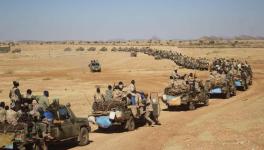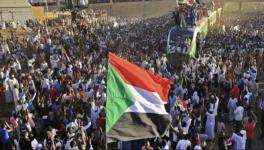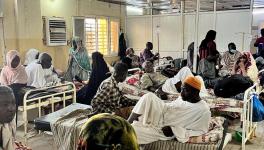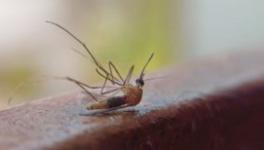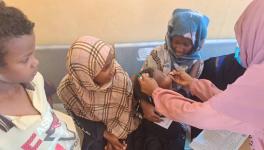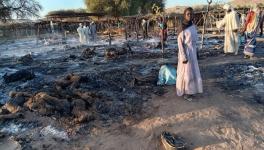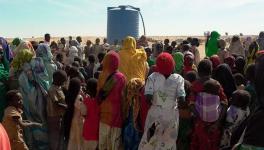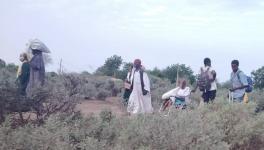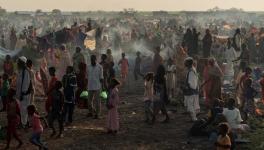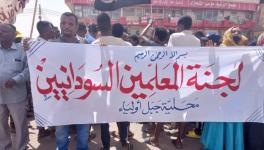Deadly Diseases Stalk Millions in War-Torn Sudan
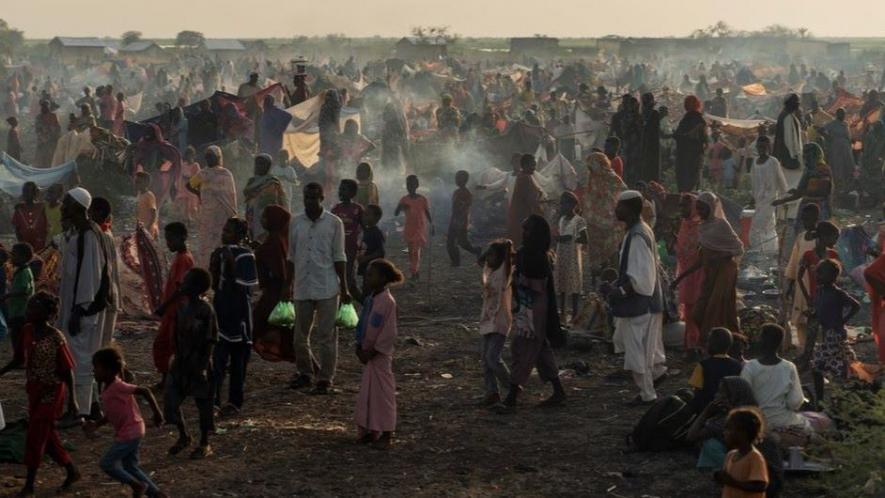
Displaced people arrive in South Sudan from Sudan through the Joda border crossing. Photo: UN News
As the war in Sudan, which has killed thousands, continues into its eighth month with no ceasefire in sight, cholera stalks millions in Africa’s third-largest country whose already fragile healthcare system has all but collapsed due to attacks and shortages.
The most vulnerable to this deadly water-borne disease is the displaced population which is “surviving in overcrowded camps, schools, dormitories and mosques,” said Rawia Kamal, an activist of People’s Health Movement (PHM) and a medical lab technician by profession.
With little or no drinking water supply in these shelters, people have to buy water carried for distribution in unsafe conditions on donkey carts. Those unable to access or afford it are forced to drink from irrigation wells or rivers, whose waters have been contaminated by defecation and washing in its streams in the absence of sufficient toilets and bathrooms for the displaced, she explained.
Kamal is one of the six million people who have been displaced so far by this war which started when the Sudanese Armed Forces (SAF) and the Rapid Support Forces (RSF), formerly ruling partners in the military junta, began fighting each other on April 15.
1.2 million of the displaced have fled to neighboring countries. The remaining 4.8 million remain displaced within the national borders, adding to the 3.7 million Internally Displaced People (IDPs) already uprooted from their homes in the previous conflicts before this war. This makes Sudan “the country with the largest number of displaced people,” according to the UN Office for the Coordination of Humanitarian Affairs (OCHA).
Amid what the UN Security Council also described on Thursday as “the world’s largest displacement crisis,” the WHO has reported at least 2,525 suspected cases of Cholera/Acute Watery Diarrhea (AWD) in five States as of November 9, with a fatality rate of over 3%. The OCHA warned last week that the disease is likely to spread to eight of Sudan’s 18 States by December, putting “more than 3.1 million people” at risk of infection.
The outbreak of the disease was first reported in the state of El Gedaref, “where Cholera cases are not new,” Kamal said. “Only 10% of Gedaref’s population has access to sanitation facilities, while only 28 percent of the state population have access to safe drinking water,” according to the UN Children’s Fund’s (UNICEF’s) 2022 report on the situation in the state before the war.
Under the circumstances, “dengue, malaria, black fever, and other diseases have been endemic in its humid climate. Cholera cases are reported every year when the rainfall peaks between June and September,” Kamal said. However, the Health Ministry used to roll out an emergency plan during these months to contain its spread, which was mostly limited to the refugees living in settlements.
As of 2020, the refugee population consisted of about 26,400 Ethiopians and Somalians who had fled the conflicts in their countries into this border state of Sudan. It has nearly tripled since, with almost 51,000 more refugees from Ethiopia after the Tigray People’s Liberation Front (TPLF) started a war with the national army in the northern part of the country in November of that year.
With an additional influx of about 270,500 IDPs from the Khartoum state into Gedaref since the war broke out between SAF and the RSF on April 15, the health ministry has failed to contain the disease.
Of the 2,525 suspected cases reported as of November 9, including 78 associated deaths, about half of them – 1,243 suspected cases and 36 deaths – are from Gedaref, where the outbreak was declared on September 26.
It has since spread to all the four neighboring states and has also been reported beyond in a fifth state, South Kordofan, on the border with South Sudan, which split from Sudan in 2011 after 22 years long civil war. Nearly 900,000 IDPs, returnees, vulnerable residents and refugees were in need of humanitarian assistance in this state as of 2022, well before the current war broke out.
Gederef’s western neighbor Gezira, which is hosting the highest number of IDPs of the current war — over 404,000, amounting to more than 8% of the 4.8 million — has reported over 500 suspected cases. More than 400 other suspected cases, including 24 associated deaths, have been reported from Khartoum state.
While the WHO and UNICEF are providing States with high concentrations of IDPs with safe water tanks and mobile toilets, Khartoum remains inaccessible, in the throes of heavy fighting, Kamal said. It is from the three cities of this state — the national capital Khartoum, and its sister cities, Khartoum Bahri (North) and Omdurman — that more than 68% of this war’s IDPs, including Kamal, have fled.
“I cannot survive in Sudan any more”
“I was living within walking distance from Khartoum’s Sports City where the first shots of the war were fired on the morning of April 15. Our neighborhood was under the control of the RSF from the first hours of the war,” Kamal recalled.
The notorious paramilitary was formed in 2013 by coalescing the militias created by the SAF during the civil war in the 2000s in the region of Darfur where alleged genocide, war crimes and crimes against humanity were committed.
“They controlled all the entrances and exits of the neighborhood and blocked all supplies. I survived 42 days in my house without electricity, running water, cooking gas, very poor internet and telecommunication, and on very limited food. We used up all the pantry contents.”
Then, on the morning of May 26, the RSF attacked her neighborhood, riddling her house with bullets. “They tortured my brother-in-law for three hours,” Kamal said.
“We gave him first aid and rushed him to a hospital. The medics did their best to stop external bleeding. But internal bleeding continued. They could not remove the bullet because there was no X-ray, no electricity, no sedatives, nothing. We ran from hospital to hospital for 12 hours, but couldn’t save him,” she told Peoples Dispatch.
Most hospitals in Khartoum had gone out of service by then, either because they were bombed by the SAF or occupied by the RSF, or had run out of supplies. Those that remained open were operating in a limited capacity. Kamal’s brother-in-law bled to death.
She subsequently fled to a safer neighborhood in Khartoum, spending the next 37 days in a two-room apartment shared with five families, most of whose members were women, children and elderly — many suffering chronic diseases.
Finally, in early July, she was able to flee Khartoum to a village in Northern State. “The journey would normally take six hours, but we took about 30 hours. We had to change several vehicles and walk long distances before making it to safety,” Kamal recalled. Waiting for an opportunity to cross over the State’s border to Sudan’s northern neighbor Egypt, she spent the next four months with a hosting family, with several other IDPs.
“69% of the IDPs are estimated to be women. But I suspect their percentage is much higher. The RSF has been targeting women, intimidating and harassing them to humiliate the men — to show that they cannot protect them. There are also cases where women were abducted from the conflict zone, chained and held in inhumane conditions, and sold for 1,000 USD in slave markets,” she added, explaining why the majority of IDPs, especially those fleeing in the first few waves, were women.
“Many of them are pregnant, but have no access to medical care,” she said, adding that life as IDPs is especially challenging for women who have been forced to share crowded spaces with strangers, without privacy or access to sanitation.
“I cannot survive in Sudan any more,” declared Kamal, with a sense of exhaustion. But Egypt, which has already received over 300,000 refugees from Sudan since April 15, has been restricting entry into its border. So she has turned around from the northern border and is traveling back down south to try Sudan’s eastern border with Ethiopia, risking violence along the way and cholera in the border state of Gedaref.
‘War awakens forgotten diseases’
Cholera is not the only disease stalking these and other states of war-torn Sudan. Malaria, dengue, and measles have already killed hundreds and infected thousands, threatening millions more while the country’s healthcare system teeters on the brink of total collapse.
Even before the war, the healthcare system was “fragile and vulnerable,” Kamal explained. The military dictatorship led by Omar al Bashir, who had seized power in a coup in 1989, had made little effort to develop primary health centers and community clinics. “It was a highly centralized system,” centered mainly around the big hospitals in Khartoum.
“People were forced to travel from across the country to Khartoum to consult specialists or even to get an MRI,” she recalled. “Many unable to afford the travel and stay in Khartoum had simply dropped out of medical care.”
With this war, most of the big hospitals in Khartoum have been forced to shut down or limit services. The health ministry itself has fled to Port Sudan along the Red Sea across Saudi Arabia, abandoning Khartoum, where corpses are rotting on the streets and houses in several neighborhoods.
Many of the corpses “have been ravaged by hungry, stray dogs scavenging for food that is no longer available to the civilians trapped in conflict zones, creating an environment conducive to the spread of numerous diseases. The rats have also emerged from their burrows in search of food, posing a threat of the deadly plague,” the Sudanese Communist Party (SCP) warned in a statement titled ‘War awakens forgotten diseases’.
The SCP, along with the trade unions and the neighborhood Resistances Committees, had played a key role in the ‘December Revolution’, which, starting at the end of 2018, had forced the ouster of dictator Bashir in April 2019. His close confidants — SAF chief Gen. Abdel Fattah al-Burhan and RSF chief Gen. Mohamed Dagalo, aka Hemeti — jointly seized power, forming a military junta with the former as its chair and the latter as its deputy.
When the mass protests continued, surrounding the SAF HQ in Khartoum, demanding that the power be handed over to civilian rule, the RSF cleared the sit-in demonstration on June 3, 2019, with a massacre that killed over 120 protesters.
However, in the face of continued resistance, which took the form of a strike, the military junta briefly shared power with right-wing political parties, before seizing all power again with a coup in October 2021, led by the chiefs of SAF and RSF together.
For the year and a half since, the two forces intensified a violent crackdown on the pro-democracy movement, killing over a hundred more protesters, before descending into a war with each other on April 15.
Since then, the healthcare system, which had already excluded a sizable portion of the population, has been decimated while deadly diseases stalk the war-torn land, where nearly half of the population is suffering hunger.
“Away from the eyes of the world and the news headlines, the conflict in Sudan continues to rage. Across the country, an unimaginable humanitarian crisis is unfolding,” Dominique Hyde, UNHCR Director of External Relations, said earlier this month.
Get the latest reports & analysis with people's perspective on Protests, movements & deep analytical videos, discussions of the current affairs in your Telegram app. Subscribe to NewsClick's Telegram channel & get Real-Time updates on stories, as they get published on our website.









